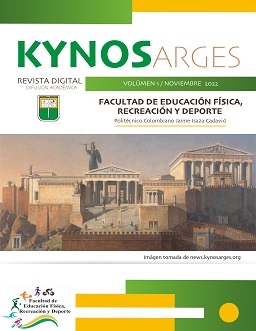Visual Narratives: perceptions of 4 blind young people, in front of the body image they express in physical activity classes, in the rehabilitating Corporation of the city of Medellin.
Keywords:
blind, narratives, physical activityAbstract
Perceptions give space to reflect on what is done in those spaces where a subject moves. Those looks are not foreign to just a handful of people, people with diverse abilities enter that team. For this work a disability was taken, the visual one. The main objective was to identify the perceptions of 4 blind young people, between 18 and 25 years old, regarding the body image that is expressed in the physical activity class. The methodology used has a qualitative and biographical-narrative approach, based on a historical-hermeneutical paradigm. In turn, the observation sheet, the narrative interview and the photobiography are used as collection instruments. A main result is that in the classes the image of the body is not only transformed by the motor movement, it is conditioned by the emotions, perceptions and methodology that is worked on. In the same way, a main conclusion is that the blind young person makes a mental construction about his body image, based on the conception he has of normal, once he makes it, he articulates two aspects: One general, evident by what he feels, he thinks and perceives of himself; and one specific, which is the help that the other gives him with specific aspects of the image that he creates. This mental image of the body is marked by events, emotions and sensations that make the young blind person act, or express himself, in a certain way in physical activity classes.
Article Metrics
Abstract: 447 PDF (Español (España)): 266References
Alheit, P. (2012). La entrevista narrativa. Plumilla educativa, 10(2), 11-18.
Bolívar, A., & Segovia, J. D. (2018). La investigación (auto) biográfica y narrativa en España: principales ámbitos de desarrollo en educación. Revista Brasileira de Pesquisa (auto) biográfica, 3(9), 796-813.
Castro-Lemus, N. (2016). Re-conceptualización del constructo de imagen corporal desde una perspectiva multidisciplinar. Arbor, 192(781), a353-a353.
de Souza, E. C., & Cordeiro, V. M. R. (2015). O lugar do escritor: diálogos sobre imagens, (auto) biografias e escrita. Revista Teias, 16(42), 70-82.
Devís-Devís, J. (2017). La investigación narrativa en la educación física y el deporte. Movimento, 23(1), 13-24.
Fernández, A. C. (2017). Educación inclusiva en las instituciones de educación superior: narrativas de estudiantes con discapacidad. Revista Española de Discapacidad (REDIS), 5(1), 43-61.
Fernández, S. M. D. (2014). Desarrollo de una ficha de observación para el análisis y evaluación de experiencias educativas en mundos virtuales. IJERI: International Journal of Educational Research and Innovation, (2), 69-82.
Flick, U. (2004). Introducción a la investigación cualitativa. Ediciones Morata.
García, J. I., & Cañadas, D. P. (2009). La formación de ciegos y discapacitados visuales: visión histórica de un proceso de inclusión. In El largo camino hacia una educación inclusiva: la educación especial y social del siglo XIX a nuestros días: XV Coloquio de Historia de la Educación, Pamplona-Iruñea, 29, 30 de junio y 1 de julio de 2009 (pp. 453-462). Universidad Pública de Navarra.
Hernández-Sampieri, R., Fernández-Collado, C., & Baptista-Lucio, P. (2017). Alcance de la Investigación.
Huchim Aguilar, D., & Reyes Chávez, R. (2013). La investigación biográfico-narrativa, una alternativa para el estudio de los docentes. Actualidades investigativas en Educación, 13(3), 392-419.
Hurtado, L. T. (2016). Inclusión educativa de las personas con discapacidad en Colombia.
Lira, G. V. (2003). A narrativa na pesquisa social em saúde: perspectiva e método. Revista Brasileira em Promoção da Saúde, 16(1), 59-66.
Lozares, C., & Verd, J. M. (2008). La entrevista biográfico-narrativa como expresión contextualizada, situacional y dinámica de la red socio-personal. Redes. Revista hispana para el análisis de redes sociales, 15(2), 95-125.
Margulis, M. (2001). Juventud: una aproximación conceptual. Adolescencia y juventud en América Latina, 41-56.
McEwan, H., & Egan, K. (1998). La narrativa en la enseñanza, el aprendizaje y la investigación (pp. 236-259). Buenos Aires: Amorrortu.
Megías, M. E. P., & Flores, J. I. R. (2019). Investigar narrativamente en Educación Física con relatos corporales. Revista del Instituto de investigaciones en educación, 8(10), 82-99.
Ochoa Palomo, C., & González Monteagudo, J. (2013). La fotobiografía como técnica de formación y de desarrollo personal. In Simposio Internacional de Narrativas en Educación. Historias de vida, infancias y memoria (2013). Universidad de Antioquía.
Rodríguez, G., Gil, J., & García, E. (1996). Tradición y enfoques en la investigación cualitativa. Metodología de la investigación cualitativa, 14.
Sanz, 2008; Mitchell y Weber, 1999, 74-123; Mitchell, Weber y O´Reilly-Scanlon, 2005, 58-68
Sánchez-Márquez, N. I. (2019). Sensación y percepción: una revisión conceptual. Bogotá: Ediciones Universidad Cooperativa de Colombia. doi: https://doi. org/10.16925/gcnc, 11.
Saucedo, A. C. G., Heredia, F. J. G., & Martínez, R. R. (2016). Discapacidad visual. Cultura Científica y Tecnológica, (51).
Torres, M. I. B. (2015). Discapacidad: una construcción narrativa excluyente. Equidad y desarrollo, (24), 165-183.
vVadillo, R. C. (2016). Percepciones sobre la inclusión de alumnos con discapacidad en la Universidad Veracruzana. Reencuentro. Análisis de problemas universitarios, 28(72), 151-178.
Vaquero-Cristóbal, R., Alacid, F., Muyor, J. M., & López-Miñarro, P. Á. (2013). Imagen corporal: revisión bibliográfica. Nutrición hospitalaria, 28(1), 27-35.
Rehabilitar, 2021. Corporación Rehabilitar. Medellín, 1-58.
Bericat Alastuey, E. (2012). Emociones. Sociopedia. isa, 1-13.
Downloads
Published
Issue
Section
License
Copyright (c) 2022 Andrés Mora Pérez

This work is licensed under a Creative Commons Attribution-NonCommercial-ShareAlike 4.0 International License.


